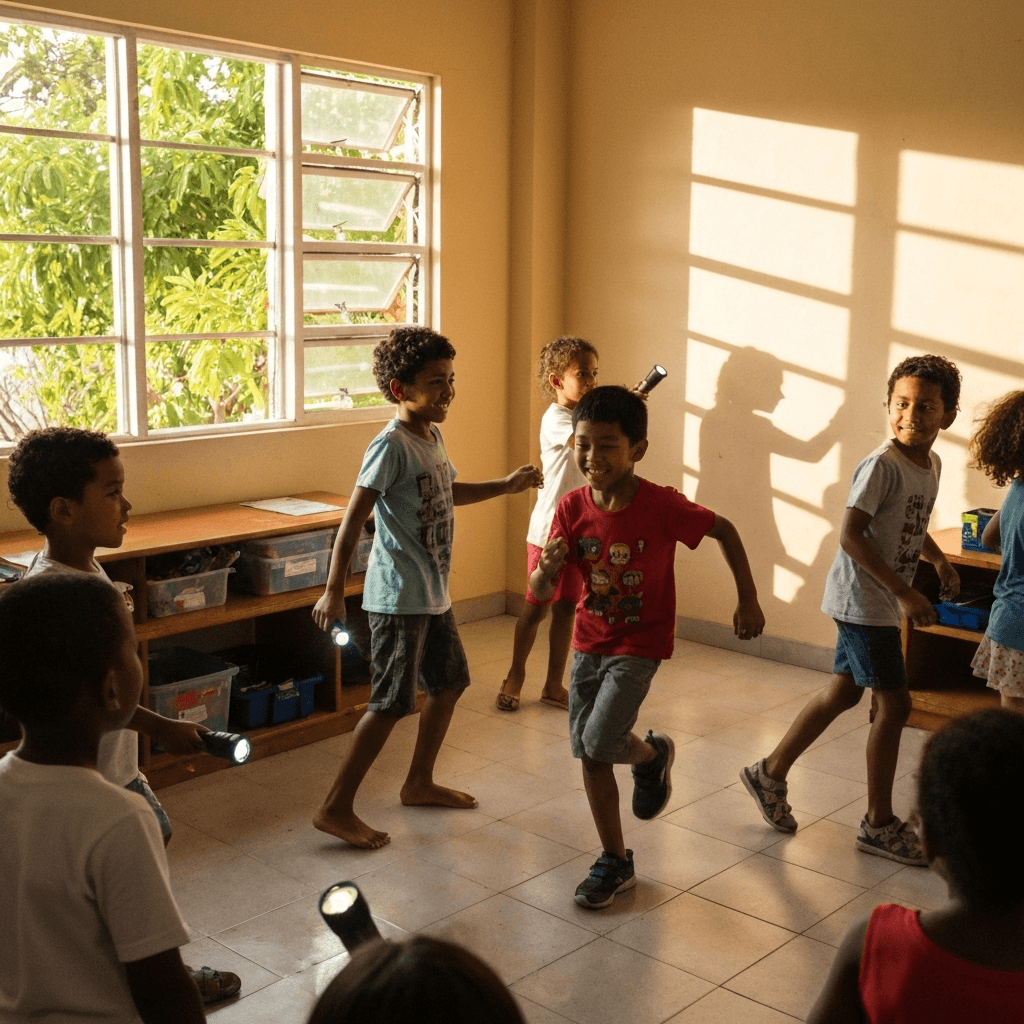Shadow Investigators
A hands-on physical science exploration where students investigate how shadows are formed, how they change, and what affects their size and shape.
Activity Overview
Shadow Investigators engages students in exploring the fascinating world of light and shadows through hands-on experimentation. Students discover how shadows are created when light is blocked by objects, investigate how shadows change throughout the day, and experiment with ways to alter shadow size and shape. This inquiry-based activity develops understanding of light behavior while encouraging scientific thinking and observation skills.

Learning Outcomes
- Understand how shadows are formed when light is blocked
- Observe how shadows change throughout the day
- Investigate factors that affect shadow size and shape
- Predict and test shadow changes
- Develop vocabulary related to light and shadows
- Practice scientific observation and recording skills
- Connect shadow phenomena to everyday experiences
Curriculum Connections
Physical Science: Light and shadows
- Properties of light
- How shadows are formed
- Factors affecting shadow characteristics
Scientific Inquiry: Prediction and experimentation
- Making predictions about natural phenomena
- Testing ideas through experimentation
- Observing and recording changes over time
Implementation Steps
1Introduction and Shadow Hunt (15 minutes)
- Begin by asking students what they know about shadows
- Take a shadow walk around the classroom or outside
- Have students find and point out different shadows
- Discuss when and where they see shadows in daily life
- Introduce key vocabulary: shadow, light, block, dark
2Shadow Creation Exploration (20 minutes)
- Provide flashlights and various objects for each group
- Students experiment with creating shadows on white paper
- Try different objects: blocks, toys, hands, pencils
- Observe what happens when light shines on objects
- Discuss: "What do you need to make a shadow?"
- Record observations through drawings
3Shadow Size Investigation (15 minutes)
- Students predict: "How can we make shadows bigger or smaller?"
- Test predictions by moving flashlight closer and farther
- Move objects closer to and farther from the light
- Trace shadow outlines to compare sizes
- Discuss findings: What makes shadows change size?
- Record discoveries in science journals
4Shadow Shape Experiments (15 minutes)
- Explore how shadow shapes change with object position
- Rotate objects to see different shadow shapes
- Use shadow puppet templates for creative exploration
- Try making hand shadows on the wall
- Discuss: "Why do shadows have different shapes?"
- Create shadow art by tracing interesting shapes
5Outdoor Shadow Tracking (Optional - 20 minutes)
- If possible, go outside on a sunny day
- Have students stand in the same spot and trace their shadows
- Return later in the day to trace shadows again
- Compare morning and afternoon shadow positions
- Discuss why shadows move throughout the day
- Connect to the sun's movement across the sky
Activity Variations
Shadow Theater
Create a shadow puppet theater where students tell stories using shadow puppets and explore narrative through shadows.
Shadow Art Gallery
Set up stations where students create shadow art by arranging objects and tracing their shadows.
Shadow Measurement
Use non-standard units to measure shadow lengths and compare shadows of different objects.
Multiple Light Sources
Experiment with multiple flashlights to create overlapping shadows and explore how multiple light sources affect shadows.
Differentiation Strategies
For Advanced Learners
- Investigate shadows created by transparent and translucent materials
- Explore how colored lights affect shadow appearance
- Research sundials and how they use shadows to tell time
- Create detailed diagrams showing light, object, and shadow relationships
For Students Needing Support
- Start with large, simple objects that create clear shadows
- Focus on basic concept: light + object = shadow
- Use guided questioning to help make observations
- Work with a partner for support and collaboration
- Provide sentence starters for describing observations
Language Support
- Provide vocabulary cards with pictures and words
- Use gestures and demonstrations for shadow concepts
- Allow drawing to show understanding instead of writing
- Connect to shadow games from students' cultures
Assessment Rubric
Shadow Understanding
- Excellent: Explains how shadows form and what affects them
- Good: Understands basic shadow formation
- Developing: Shows some understanding with support
- Beginning: Needs significant guidance
Prediction and Testing
- Excellent: Makes logical predictions and tests them systematically
- Good: Makes some predictions and tests with guidance
- Developing: Makes basic predictions with support
- Beginning: Needs help making and testing predictions
Scientific Vocabulary
- Excellent: Uses shadow vocabulary correctly and confidently
- Good: Uses some shadow terms appropriately
- Developing: Uses basic vocabulary with prompts
- Beginning: Limited use of scientific terms
Materials and Safety
Essential Materials
- Flashlights (one per small group)
- Various objects for creating shadows
- White paper or wall space for shadow projection
- Chalk for outdoor shadow tracing
- Shadow puppet templates (optional)
- Science journals and pencils
Safety and Setup
- Ensure flashlights have working batteries
- Supervise flashlight use to prevent shining in eyes
- Create clear workspace boundaries for each group
- Have extra batteries available
- Darken room partially for better shadow visibility
